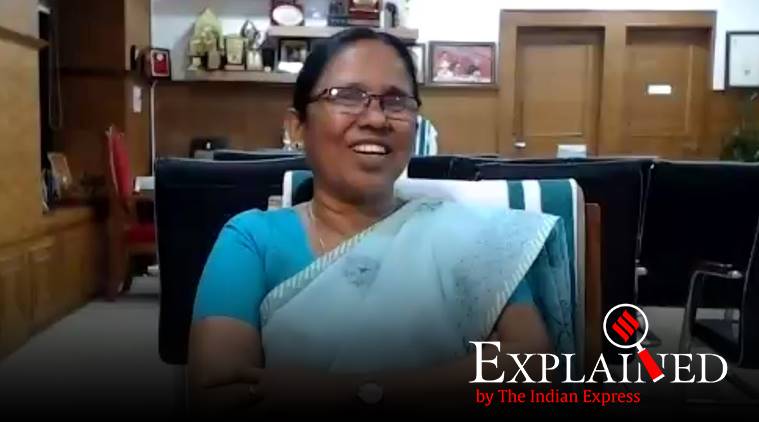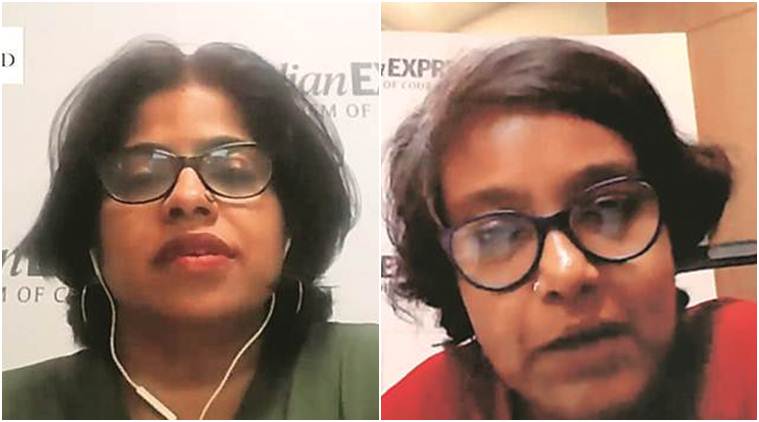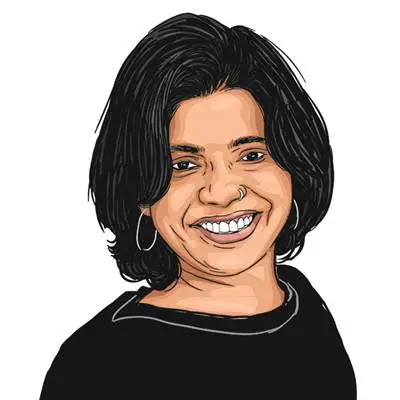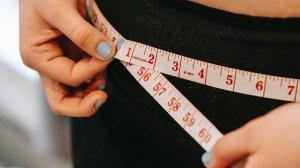- India
- International
Health Minister K K Shailaja on Kerala’s Covid-19 success: ‘Our strategy is trace, quarantine, test, isolate and treat’
In this E-Xplained episode before a nationwide audience on Zoom, K K Shailaja, Kerala Health Minister, discusses how Kerala kept the numbers down, and looks at the challenges ahead.
 Kerala Health Minister K K Shailaja in conversation on Zoom.
Kerala Health Minister K K Shailaja in conversation on Zoom.
K K Shailaja, Kerala Health Minister, has made global headlines for the state’s handling of Covid-19. In this E-Xplained episode before a nationwide audience on Zoom, she discusses how Kerala kept the numbers down, and looks at the challenges ahead. Edited excerpts:
On Kerala’s robust Panchayati Raj and healthcare systems
In Kerala we implemented [Panchayati Raj] in a democratic way. Our local self-governments are fully charged with power and the distribution of money is also like that… Our Primary Health Centres are now under the panchayat, local-level panchayat. They are well planned; they are implementing so many novel projects in the Primary Health Centres with the help of the Health Department also. It is now under the Health Department but the local self-government is the authority in that place and that PHC is under their jurisdiction.
On using technology for contact tracing
Yes, I think the most important thing is planning preparedness. When we heard that some novel virus is spreading in China, Wuhan, we anticipated that the virus will come to Kerala definitely because so many Malayalees are in Wuhan, and we started our planning in January itself. I think you know that on January 18, WHO declared that a potential virus is there in Wuhan. At the time WHO didn’t declare it as a pandemic, but when we heard about the novel virus, a new kind of virus from the SARS family, corona family, at once we started to discuss that. My health secretary and my team and I had a meeting and discussed this new kind of virus and we started our planning. On January 24 we had a very good meeting of our Rapid Response Team. We opened our control room at the state level and we informed all 14 districts, district medical officers (DMOs). They also started district-level control rooms. In each control room we have added expert groups. Every Additional DHS and other higher official has one or two duties. One is responsible for contact tracing, another is responsible for making isolation rooms and Covid hospitals, and someone has the duty of logistics collection, and even mental health.
As we expected, the coronavirus came from Wuhan to Kerala. On January 30, we got the first positive case, and in February first week, we got two other cases. But when we tested the samples, all three students were in our isolation ward in hospital. That was our success because no contact occurred, no transmission of this virus occurred from there. After that, in February end, again people were coming from other countries. At that time the virus had spread all over the world — Italy, UK, US, everywhere — and people started to come back from these countries to Kerala. But our surveillance team was at the airport — we didn’t withdraw the team — and they were examining all the people who were coming back. Our strategy is: trace, quarantine, test, isolate and treat.
Read | Dealing with Covid-19 pandemic: Why the ‘Kerala Model’ is working

On the recent resurgence of cases following a decline last month:
Yes, definitely, but we expected that earlier. During the March-April lockdown… travel stopped, no one was coming from abroad or from other states of India, and we got some positive cases among whoever returned at that time from other countries, and we were dealing with those positive cases… But the situation changed when the lockdown lifted, when air travel was reinstated, and surface travel also restarted. People again started to come back from other countries and also from other parts of India. Clearly we expected that, we planned for that also… definitely there will be a second wave, we thought like that.
People who returned, there are so many positive cases among them, and we are examining them. We are tracing them at the airport itself. Not only the airport, they are coming by water; in the seaport also we have a very good tracing team; — and also by road; our checkposts are there. At railway stations also, 15-20 desks are there. More than 1.5 lakh people returned this time from the Gulf countries; a number of people tested positive. And also from Chennai, Maharashtra — the most positive cases we got were from Maharashtra, Mumbai; and the second most were from Chennai and from Gujarat also. Not only are they positive, but also some of the people who returned from these epicentres… were in a pathetic condition. A woman who returned from Mumbai to Kerala by car didn’t go to quarantine but directly was admitted to the hospital because she was so sick. When she entered the hospital, at that moment she died. That is the condition of the people who are returning. That is why our positive cases are increasing, and deaths are also increasing.
On the strain put on health systems by the large numbers returning
Yes, we planned for handling this kind of severe situation. Definitely this is challenging, but we have Plan A, Plan B, Plan C etc. In Plan A, we have three Covid hospitals in every district and I think more than 1,500 beds for Covid patients in [each] hospital. And in Plan B we have more hospitals. We are changing the hospitals to Covid hospitals, and 5,000, — up to 10,000 — we can handle in these circumstances. In our Plan C we are arranging some hotels, hostels and some auditoriums for Covid patients; that is under our consideration, and we have a very good list of institutions. And also, we are listing the human resources, not only in the government sector, but also in the private sector. We have a very good list of medical resources and we are giving training to them to handle the situation if [many] positive cases occur.
 Kerala Health Minister KK Shailaja was in conversation with Liz Mathew and Abantika Ghosh.
Kerala Health Minister KK Shailaja was in conversation with Liz Mathew and Abantika Ghosh.
It didn’t go beyond our expectations because we expect that if 1.5 lakh people come, 5,000 or something will be the positive [cases] number… Six lakh people were registered on our portal to come back to Kerala, and out of that we will get a good number of positive cases. That is not a problem. The problem is that if the people who are positive are not obeying our quarantine principles, contact will occur, human-to-human transmission will occur. If one can transmit this virus to four people, from there it will become 40, and from there it will become 1,000 or 600 or become any number. That will go like a progression or like an atomic chain reaction; it will grow.
Read | Behind containment in Kerala: robust healthcare system, effective strategies
On the possibility of community transmission
We cannot say that community transmission will not occur, but now there is no community transmission in Kerala, because we are examining everything. If we get a case from outside the contacts or outside the “import” cases, we are thoroughly tracing the contacts from where it occurred, and we are doing sentinel surveillance tests also. We have already conducted more than 15,000 surveillance tests and out of that only a few positive cases we got, and in these also we found some relationship with the positive cases or some contact, some history of travel, etc. That is why we are saying community spread hasn’t occurred. Also, we are testing peripheral pneumonia cases — and peripheral pneumonia cases decreased this time. We collect some augmented samples from all parts of the society, at a time 3,000 etc; out of that we didn’t get more positive cases. That shows that the virus hasn’t entered the community. But tomorrow, if quarantining becomes a failure — we don’t think so, but if it happens anyway — then community spread will definitely occur.
On whether Kerala is testing enough
Yes, testing is most important. But we are not following the slogan, “Test, test, test, nothing else”. We are testing in a strategic way. Our most important thing is tracing first and testing the symptomatic cases first. And the others who have a travel history or some contact history, we are properly quarantining them,. And if any symptoms occur in the quarantine period, we are shifting the patient to hospital, and again we are taking swabs and testing. But we should be very thorough so that the quarantine is scientific. With the help of local self-government, with the help of anganwadi workers and helpers, with the help of ASHA workers, we are watching the people in their house, keeping in contact with them by telephone and also going to the doorstep. We are examining whether the person is [staying] in quarantine or jumping quarantine. Every day, we are calling and finding out if they have any symptoms. At once, we are sending our ambulance to the house and shifting that person to our hospital and taking samples and testing.
Opinion | Kerala’s investment in social sectors is helping combat Covid-19
That is our testing method. We are continuing that, and we are slowly increasing the tests a little. When new people are coming from the epicentres, we have to increase tests among the highest contacts and also secondary contacts. Random testing is also there and sentinel surveillance testing is there. Now we are increasing our testing, but testing everybody is not necessary. That will finish our testing kits etc, and after that we should have to cry because we cannot touch the proper cases at that time. That happened in some countries — I think in Italy and USA, they used all test kits in the first part. They had no proper strategy for testing at that time, only one slogan, “Test, test, test”. That cannot be a good method and we are testing according to our strategy and we think this is a scientific strategy.
Audience Questions
On her message to others who are combating Covid
We have implemented tracing and quarantine, testing, isolating and treating the patients or virus carriers properly. The most important thing was chain-breaking. And, people should have some health behaviours, some habits, some responsibilities to break the chain; or the people should obey the advisories of our health system — handwashing, mask, keeping physical distance etc. That we have to do for a long period. How long this virus is here, up to that period we have to do some behavioural changes. That is the only method. Every individual is responsible; our health is our responsibility. That is the slogan here: “My health is my responsibility”.
📣 Express Explained is now on Telegram. Click here to join our channel (@ieexplained) and stay updated with the latest
On her frustrations about the absence of a vaccine or drug:
Yes, everyone has these frustrations and anxieties, because we are eagerly waiting for a vaccine. Every day we are reading everything which comes in newspapers, media and even Lancet journals etc — whether [there is] any good news from any part of the world, how many experiments are going on. As a science teacher, I am sure that one day they will find out a very good vaccine against this deadly virus.
Transcribed by Mehr Gill
More Explained
EXPRESS OPINION
Apr 23: Latest News
- 01
- 02
- 03
- 04
- 05










































